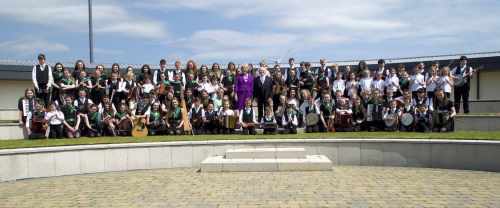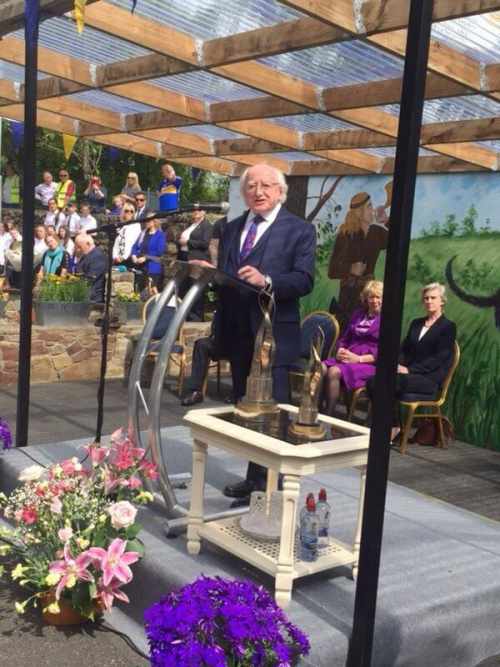Speech at the opening of the Cabragh Wetlands Centre
Thurles, Co. Tipperary, Saturday 19th May 2018
Mayor,
Your Eminence,
Deputies,
Councillors,
Dear friends,
It is such a pleasure for me to join you here in the Cabragh Wetlands Trust this afternoon to open this marvellous new facility, to have the opportunity of visiting what is not only a site of profound ecological importance, one that is host to so many diverse habitats and species, but also one that is of immense social importance, being as it is a testament to the determination of so many of the people of Tipperary to preserving our wetlands and educating our people.
That this project was born at a challenging time for the workers of Thurles and the beet farmers of Tipperary when, in 1989, Comhlucht Siúicre Éireann decided to close the sugar factory which had been such a fixture of the economic life of this area since 1934.
The challenge that ensued was not only economic and social, it was ecological, as the decision to fill in the ‘settling ponds’, which held the sludge produced by the process of washing the beet prior to production, had the potential to drive away the waterfowl who made this area a wintering spot since the 1960s.
Visionary citizens of Thurles and Tipperary responded by establishing the Cabragh Wetlands Trust in 1993, and may I commend their courageous decision to acquire these wonderful wetlands. Looking back, this most important intervention demonstrated the potential of this community, this town, and this county to overcome the closure of the sugar factory through the preservation and creation of a new symmetry between humanity and nature.
It is also humbling to recall that the Trust began its work at a time when the State’s capacity, and indeed its willingness, to confront our ecological challenges was still yet in its infancy. As a former Minister with responsibility for our natural heritage I recall the enormous obstacles placed before those who sought to protect our native habitats and species. As a nation, so much of our success in protecting our ecosystems is down to the success of volunteers such as those of you gathered here today.
That success is displayed not only in the maintenance of wetlands, bogs and ancient woodland throughout our island, but through the increasing numbers of our citizens who are now hungry for knowledge about the land in which they live and work.
This magnificent new Centre, the result of years of unremitting labour and activism, will be a landmark for all those who seek a deeper understanding of our natural heritage – whether they be artists, scientists, photographers, walkers, or students.
I am deeply honoured that my own words, from my poem ‘Stardust’, adorn the new Cosmic Walk. An important and intellectually engaged artistic endeavour, the Walk invites us to reflect on the place of our species on our shared and increasingly vulnerable planet.
The ninth sculpture, a hollow yew trunk, reminds us that our ancestors, Homo habilis emerged over 2 million years ago, a mere blink in geological time. Though these first humans began to transform our planet, hunting what now appear to us as strange and exotic megafauna, it was only with the commencement of the current geological epoch, the Holocene, which marked the end of the Ice Age, that a new type of human civilisation arose.
This new human culture wrought a new relationship between humans and nature through the domestication of animals, the cultivation of the soil, and the erection of towns and villages. In this Neolithic Revolution our species cleared the vast forests, altering habitats and ecologies.
Men and women became workers of the land and tillers of the soil, and yet others, let us not forget, became administrators in the new hierarchical society which came into being to co-ordinate production, distribution and consumption.
It was only 200 years ago that this civilisation, powered by muscle and sinew of humans and their domesticated animals, gave way to a new industrial order, one that relied, and continues to rely, on energy produced by the combustion of the carbon sequestered in the bogs, in the forests, and under the earth and the seas over many millions of years. This carbon-based culture emerged in Europe and North America – it distorted and warped the vital confluence between economy, ecology and ethics, elevating a narrow vision of society, one that sanctioned war, exploitation and imperialism.
The vastness of geological time, the ineluctable influence of the rotation of the Earth around of the Sun, the slow changes wrought in a hundred thousand habitats by millions of species – all of these processes have now been eclipsed by the influence one species, our own, now exerts on the ecology of the planet. The Nobel Prize winning chemist, Paul Crutzen has suggested that we should recognise the age in which we now live as a new epoch in geological history - the Anthropocene, an age defined by humanity.
We are now witnessing the most negative manifestations of human influence: the catastrophic effects of climate change produced by the emission of greenhouse gases and changes in land-use such as the drainage of bogs and wetlands; the alteration of the phosphorus, sulphur, and as we know so well in Ireland, the nitrogen cycles, each one an ecological process vital to life on our planet; disruptions to the terrestrial water cycle, so vital to rainfed agriculture in a pastoral economy such as our own; and of course, most tragically, the onset of the sixth great mass extinction event in the history of our planet, in which so much biodiversity has already been lost.
These global changes can seem overwhelming – they are planetary problems, and they require planetary solutions. Yet, there is hope. In the final months of 2015, the nations of the world assembled together in New York and Paris to conclude two landmark agreements: the Sustainable Development Goals and the Paris Climate Accord. These two remarkable demonstrations of global solidarity and commitment will organise and measure our efforts in this century. If we stay faithful not only to their letter but to their moral intent, we will have demonstrated the ‘new and universal solidarity’ to which Pope Francis has so often summoned us in his calls for global social and environmental justice.
The Department of Communications, Climate Action and Environment is responsible for the co-ordination of the implementation of the Sustainable Development Goals and the Paris Climate Accord in Ireland, and I know all are called upon to support them in their efforts, and, perhaps most importantly, to encourage them towards further action when we must.
Our efforts cannot be given effect in the conference rooms of the United Nations – they begin in our own countries, though I know that I do not have to remind any of you here today of this fact. You have been to the forefront of wetlands conversation and nature education in Ireland nearly thirty years, and have long promoted the combination of ecology, culture, art, and education that will be so necessary in the years ahead.
This Centre is a fitting testament to your efforts over the many years. It is, in the midst of our planetary emergency, more urgently required than ever before, for it provides us with hope for a better, more socially just and ecologically sustainable future.
May I then pay tribute once again to all those who brought this vision into being, in particular the Chairman of the Trust, Tom Grace, and wish you all the very best in the future.


